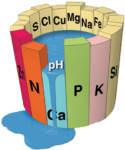 Plants need all the necessary nutrients, i.e., 17 elements, in order to produce an adequate yield; macroelements – taken up in larger quantities – and microelements – in much smaller amounts.
Plants need all the necessary nutrients, i.e., 17 elements, in order to produce an adequate yield; macroelements – taken up in larger quantities – and microelements – in much smaller amounts.
Suppose one of the essential nutrients is missing or insufficient. In that case, the deficiency of that nutrient causes disturbances in the plant’s metabolism. According to Liebig’s Law of the Minimum, the plant’s yield is limited by the shortage of that particular nutrient.
Each plant species has a specific macro-and micronutrient composition and takes up different amounts of the individual nutrients. The nutrient requirement of a plant species corresponds to the amount of the required nutrient that the plant must take up during its ontogenetic development to produce a maximum yield. Under field conditions, the plant’s nutrient requirements are met by fertilisation, depending on the soil’s nutrient availability.
Specific (unit) nitrogen uptake 1)2)
| Type of crop | Nutrient uptake (kg N per 1 tonne product) |
| Cereals | |
| Buckwheat | 41.7 |
| Spring malting barley | 21 |
| Fodder spring barley | 24 |
| Winter barley | 24 |
| Grain maize | 26 |
| Grain cereal mixes | 27 |
| Grain legume mixtures for grain | 15 |
| Oats | 22.2 |
| Spring wheat | 27 |
| Winter wheat | 27 |
| Triticale | 27 |
| Rye | 24 |
| Fabaceae | |
| Horse beans, seed | 8 |
| Peas, seed | 8 |
| Grass pea | 8 |
| Lupins, seed | 0 |
| Saradella | 8 |
| Lentils | 8 |
| Soybean, seed | 15 |
| Vetch | 8 |
| Oil seeds | |
| Mustard, seed | 60.5 |
| Rape, seed | 50 |
| Turnip rape | 50 |
| Sunflower, seed | 55 |
| Roots | |
| Sugar beet | 3.5 |
| Fodder beet | 2.5 |
| Late potato | 4.2 |
| Early potato | 3.3 |
| Other | 2.5 |
| Fodder | |
| Lucerne, green matter | 0 |
| Fodder cabbage, green matter | 4.2 |
| Clover, green matter | 0 |
| Maize, green matter | 2.4 |
| Cereal-legume mixtures, green matter | 1.5 |
| Leguminous grass-legume mixtures, green matter | 3.0 3) |
| Oats, green matter | 4 |
| Rapeseed, green matter | 4.5 |
| Saradella, green matter | 0 |
| Sunflower, green matter | 4.2 |
| Grasses grown in the open field, green matter | 5.1 |
| Rye, green matter | 4.1 |
| Other faba bean, green matter | 4.8 |
| Other non-beans, green matter | 4 |
| Other, including permanent crops | |
| Hops | 75 |
| Hemp | 40 |
| Oil flax, seed | 40.3 |
| Fibre flax, straw | 49.5 |
| Tobacco, dried leaves | 50 |
| Energy crops | |
| Miscanthus giganteus | 8.4 |
| Sida hermaphrodita | 7 |
| Other | 7 |
1) The values quoted relate to the uptake per unit of main product, for example grain, with a corresponding quantity of by-product, for example straw.
2) For crops not mentioned in the table, data on crops which are botanically or agriculturally closest to the intended crop or literature data on nitrogen uptake by crops are used.
3) Amount of nitrogen for each swath.
Average uptake of other macro-and micronutrients by selected crops per 1t of the main crop with the corresponding amount of by-product
| Crop | Macronutrient uptake in kg | Micronutrient uptake in g | |||||||
| P | K | Mg | Ca | S | B | Cu | Mn | Zn | |
| Winter wheat, grain | 4.3 | 12.5 | 2.3 | 3.6 | 4.1 | 5 | 8 | 82 | 59 |
| Spring wheat, grain | 4.5 | 13.5 | 2.3 | 4.2 | 4.1 | 5 | 8 | 106 | 71 |
| Maize, grain | 5.4 | 23.2 | 5.7 | 6.7 | 6.6 | 11 | 14 | 107 | 85 |
| Rape, seed | 9.7 | 33.2 | 5.7 | 41.3 | 12.5 | 51 | 10 | 100 | 64 |
| Horse beans, seed | 7.1 | 30.2 | 3.3 | 14.9 | 6.0 | 32 | 19 | 45 | 96 |
| Potato, tubers * | 0.6 | 5.5 | 0.3 | 0.4 | 1.5 | 2 | 2 | 6 | 6 |
| Sugar beet, roots * | 0.7 | 5.4 | 1.1 | 5.0 | 1.0 | 7 | 3 | 28 | 14 |
| Red clover, green weight * | 0.6 | 5.1 | 0.5 | 2.7 | 1.5 | 4 | 2 | 13 | 9 |
* – fresh matter
Knowing the amounts of nutrients carried with 1 tonne of the crop (table), the plants’ nutritional needs can be easily calculated, depending on the expected yield by multiplying the individual uptake by the anticipated crop yield per hectare and then calculating the nutrient requirement of the plants under the conditions of a specific field and the abundance of soil.
